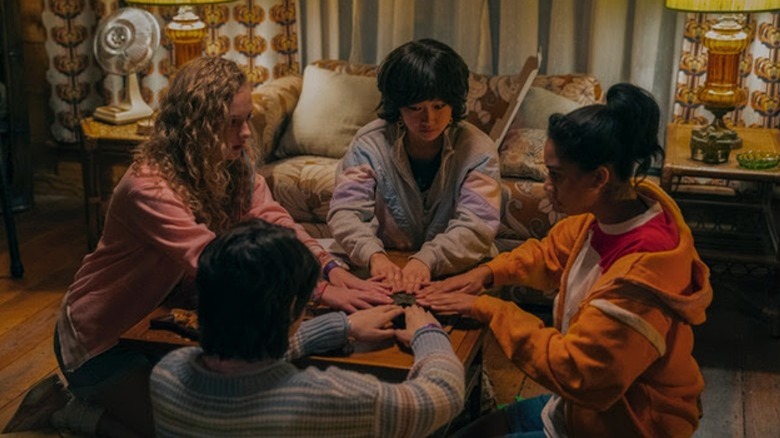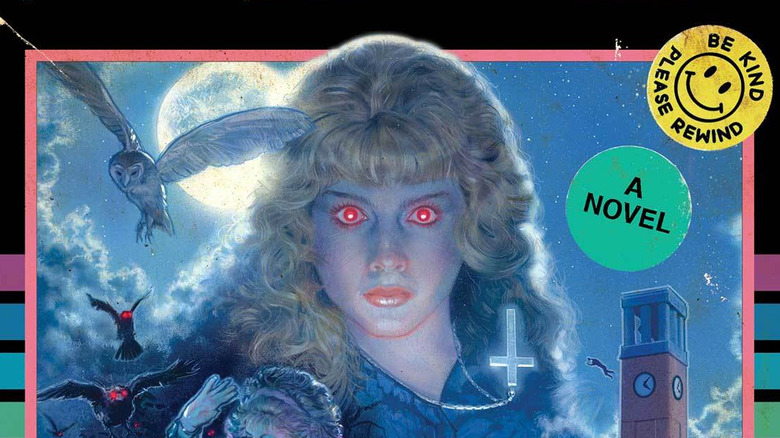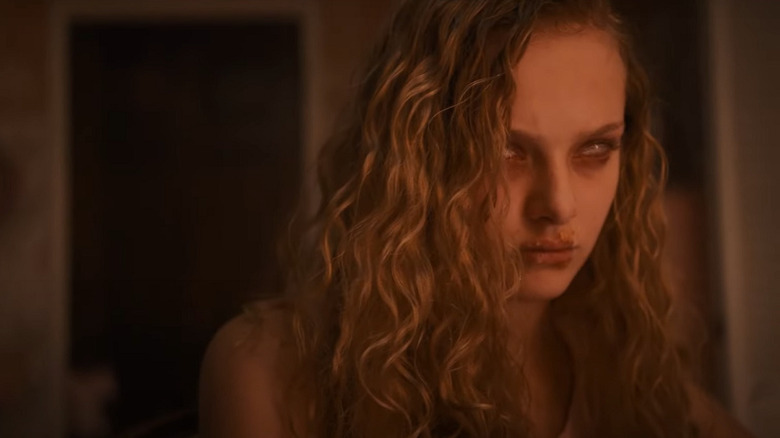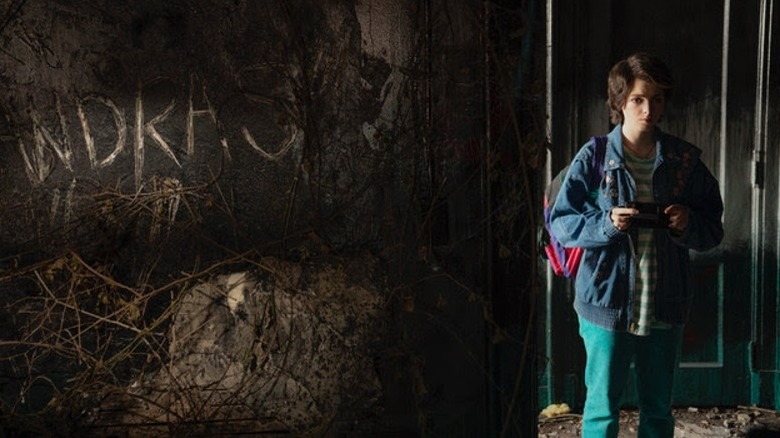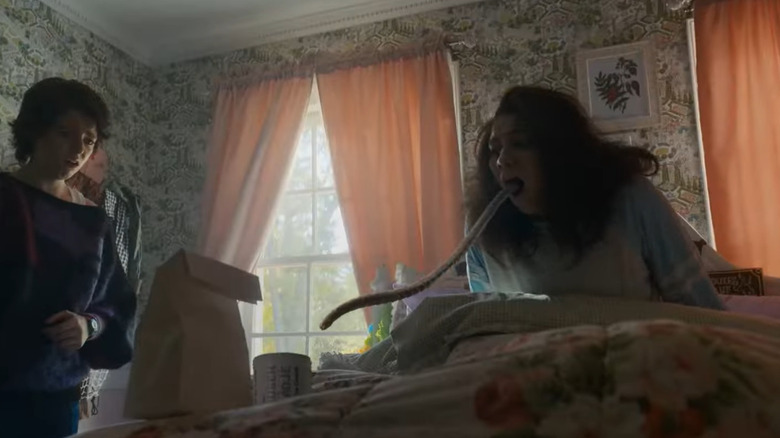My Best Friend's Exorcism Director Delves Into The Tender, Coming-Of-Age Horror Adaptation [Exclusive Interview]
Before directing "My Best Friend's Exorcism," Damon Thomas had been no stranger to entering worlds full of monstrous beings and people. Having worked on hit television shows like "Penny Dreadful" and "Killing Eve," Thomas has an eye for focusing on stories where women take down bullets, vampires, secret agents, and varying evils of the patriarchy.
However, directing an adaptation of Grady Hendrix's beloved book gave Thomas a new challenge: How can one make an entertaining exorcism film filled with as much heart as guts? Described by its publisher Quirk Books as "Beaches" meets "The Exorcism," Hendrix's novel is known for exploring the daily horrors of adolescence through a demonic romp. At its heart, it's about Gretchen (Amiah Miller) and Abby's friendship (Elsie Fisher) surviving these stressors. Possession becomes a metaphor for women's connection with their bodies and how the world around them (and their interior worlds) changes once puberty strikes.
When speaking to Thomas about his adaptation of Hendrix's work, he described how he wanted it to feel like a "lost film of the '80s." Unlike other exorcism films that overly rely on gore and vomit to craft their scares (see: "The Haunting in Connecticut"), he joined the project because screenwriter Jenna Lamia ("Resident Alien") brought a feel-good take on a subgenre typically surrounded by dread. We delved into how much explicit body horror made it onto the big screen and his thoughts on the tubular tone of "My Best Friend's Exorcism."
'I'm much more interested in exploring ideas...'
Before delving into "My Best Friend's Exorcism," I wanted to ask you about your previous directing work. You've directed episodes on two of my favorite series — "Penny Dreadful" and "Killing Eve." I'd love to know what draws you to works featuring women battling monsters of all sorts?
[Laughs] I don't know... I think "Killing Eve" gave me an interest in [it]. I think we've seen a lot of men be immoral — doing bad things and not being judged. I think when Villanelle [Jodie Comer] came along, it was so refreshing, wasn't it? She could just be really bad and we sort of loved her. It was so liberating. I really enjoyed that as a director and directing Eva Green [in "Penny Dreadful"] as well. I really like to see women in those roles. I think it's really refreshing as a director because you're not just going over ground that you've seen before.
So when it came to "My Best Friend's Exorcism," I really enjoyed the script. I felt there was a real opportunity to make a lost film from the '80s. [Having] grown up in the '80s, to slightly revisit it and see how those views differ from now. We just see the world so differently in terms of sexuality and all sorts of really interesting things in this post-Villanelle world. It's good to look back, and I'm really interested in women characters that can do anything they want. I really like that.
This film has an R-rating, which I was surprised about –
– does it? Huh...
It made me curious since this film does cover exorcisms, how did you approach how much body horror you wanted to show on screen?
Again, going back to "Killing Eve," it's so easy to go down a cheap route — I'll say. I'm much more interested in exploring ideas. I came up with that scene in "Killing Eve" where they go to the old musical and have a dance because I wanted to show physical content that wasn't sexual. That was about intimacy. There was about emotions that was about connection.
I think to tell this story, we didn't need that. We didn't need to go down that route. So I thought we could do much more in terms of the characters... I'm surprised it's got an R rating. I really am because I thought it was quite tame. I really wanted to not go and make it incredibly scary because I just thought it wouldn't fit with the rest of the movie.
When you think about "Heathers," that seemed very shocking at the time. But it's a bit tamer now, doesn't it? But I thought [this film] was more charming. But I knew people out there we'll see it and say, "Oh, it's not that scary." But that's because I didn't want it to be. It's a different territory. Sometimes you don't want the movie to go there 'cause then it feels like, "Oh, well, it feels like we're in a different movie now."
'Filmmaking is a weird marathon...'
Yeah, it definitely feels like a coming-of-age film first.
Yes.
Like sure, it's still horror but that's not its total focus.
Yeah, you want to learn something about the human condition, don't you? That's what movie makings about. Some people just want to be scared and have so much more gore and that's not this kind of movie. It's not what I set out to make, and it wasn't in the script. My job as a director is to realize what's in this script. It's not like, "Oh, now I'm going to make a different kind of film."
Without spoiling it, there's one worm scene in the film that's adapted from the book. It looks like a mixture of practical and digital effects were used and am curious what it was like bringing that scene to life? Did it go as you'd imagine it would during filming?
Yeah, it's... The boring side of filmmaking is that you're constricted by time, budget, and the pandemic. But obviously, when films come out, you're all judged on a level-playing field. You're just judged, aren't you? You trying to do the literal best you can. A scene like that one was shot in one day. So Rachel Ogechi Kanu had to spend hours and hours moaning. What's so interesting thing about performance is: some actors can't go there. They're really good actors, but then you go, "Now you got to give me your sicking up the tapeworm..." [laughs] And so, yes, you have to storyboard it, and then go when we do the interaction [on-screen], we need something physical. We need to have something to interact with that then gets retextured. So we made tapeworms that could be used. Sometimes they weren't strong enough, or you have all these have technical issues. Filmmaking is like a weird marathon. We are running against time, but you want to, and then of course, you have all the visual effects that go on for months afterwards, where you're going in at the textures, right? We don't have just the ability to just keep working forever and ever. You have a time limit. I don't want to sound like those are excuses. I think that scene was adapted really well.
'I wanted it to be a monster they could actually beat...'
Yeah, I think it came out well. I always think about effects when chatting with horror directors wondering like, "Oh, how many takes did that take? One shot only?" There's also a lot of vomit in this scene so I imagine the set was super messy.
Yeah. [Laughs] Since "The Exorcist" in 1973, it gave [filmmakers] a benchmark of exorcisms. Are you going to do the speeding ahead? Are you going to do the vomit? — things like that. I think as a filmmaker, you either reject tropes or embrace them. There are a lot of horror films made all the time and they usually tend to get very scary and super violent — like dark pits with monsters with big teeth and rotting flesh. Again, I wanted "My Best Friend's Exorcism" to be a little bit different.
Yeah, like there's vomit in here but it's just grey and not sexy. Not like vomit is sexy [laughs] but it's not that black sludge kind of style. It's just like, "Oh, that's gross."
Yeah! That's what I wanted it to be: gross. But also, I wanted it to be a monster that they could really beat. Sometimes you get these monsters and they're enormous and they've got 10,000 teeth. But suddenly, they just get really easily defeated [laughs]. I loved that the book is essentially all about friendship. A friendship is the thing that gets the demon out. And then there was... I don't think watching this film, you're going to expect a CGI creature.
I didn't. I thought it'd just stay in manifestations of her body. Speaking of that monster, how did you decide on that look? Was it more straight from the page or did you play around with differing types?
I thought it should be something combined with a small chicken-hybrid-man because of the owls. Andras — the demon — the owls are a symbol of him. So we tried to weave owls into it and have it be a presence, which is kind of nice. So that's how we came out with it. Folks, a Canadian visual effects company, gave us a guy that specializes with monster creation. I described it and he got it pretty much straight away and came back with this creature. We then refined, as you do, along the way. Did you enjoy it?
'People have very strong feelings about horror movies, don't they?'
Yeah, I was surprised at how tender it was. I don't think there's a lot of feel-good horror out there right now so am always curious to see it.
Yeah, it's that weird thing... People have very strong feelings about horror movies, don't they?
Yes. They do.
I thought, "What's the point of making something that's exactly something else?" As a filmmaker, you're trying to do that and get that [original] tone. I thought that Chris Lowell's Lemon was true to the character. It's interesting because we watched the film with a lot of people last night. We had like 300 people there, and once he wants the demon shows himself, he literally goes, "Yes!" At moment, everyone laughed because it dispelled the tension in the room. But it was really truthful because that's exactly what he would do in that situation. He was like so chuffed. It was really interesting to see where people laughed and how they enjoyed it.
"My Best Friend's Exorcism" is streaming now on Prime Video.
